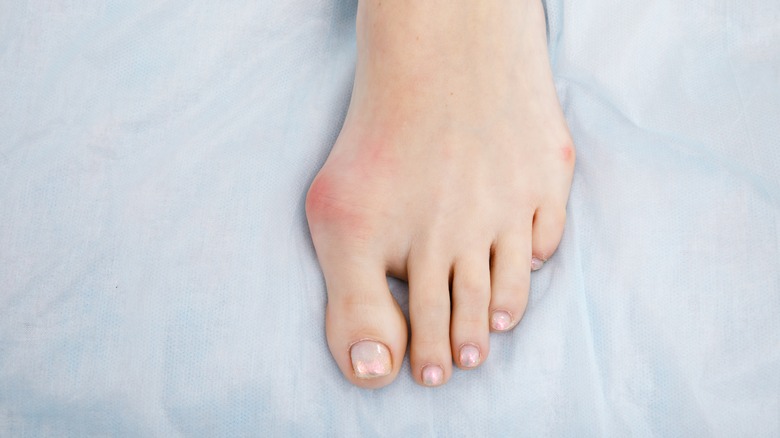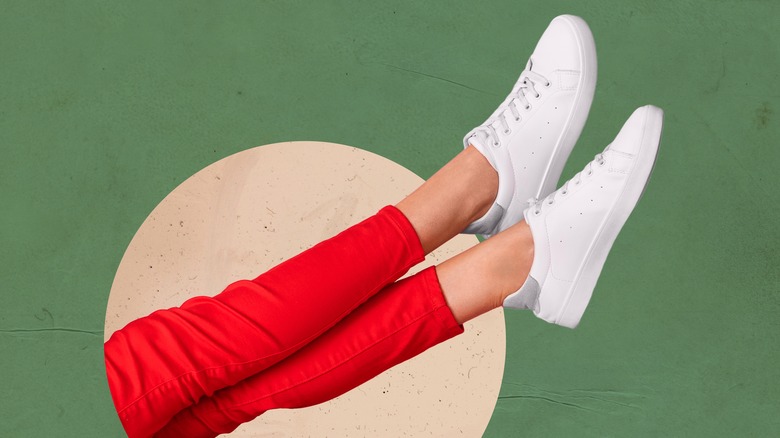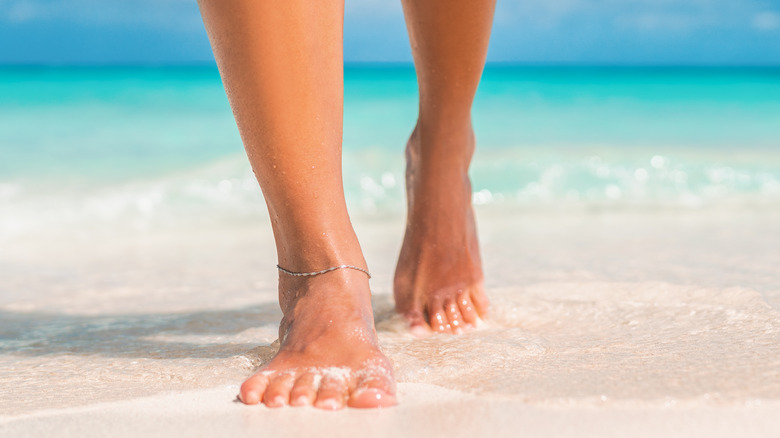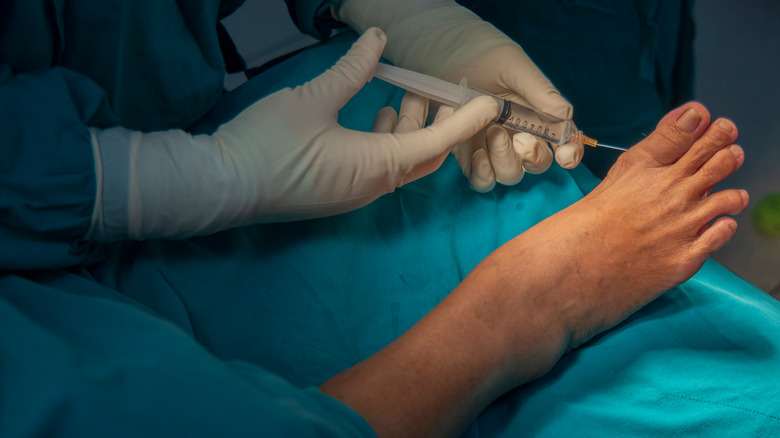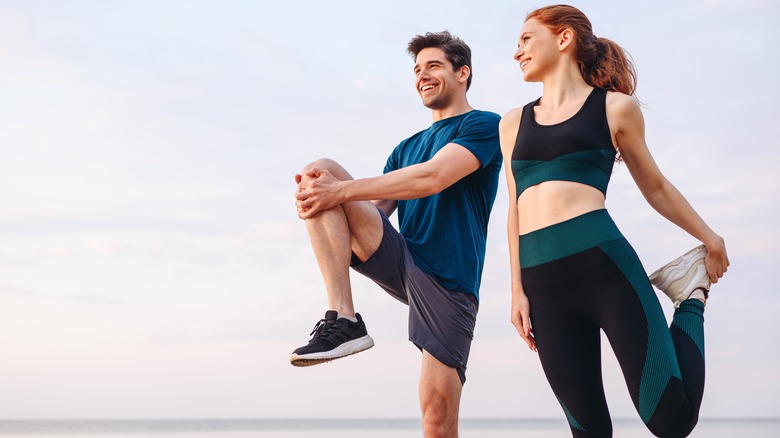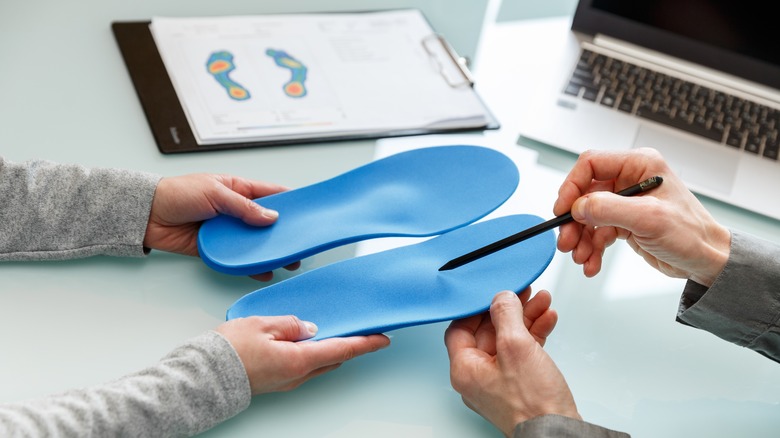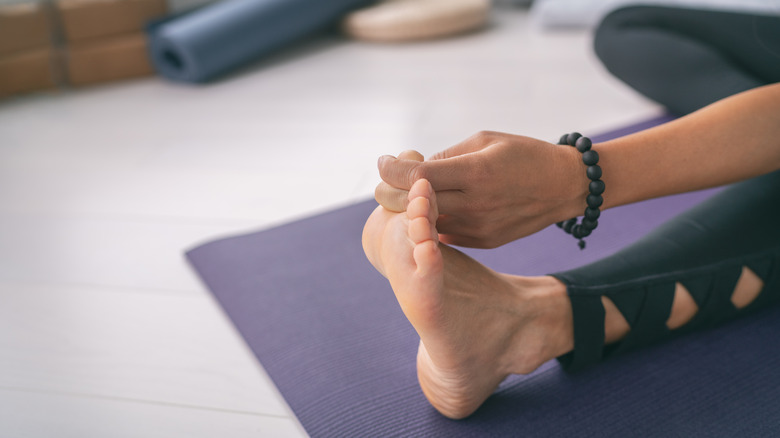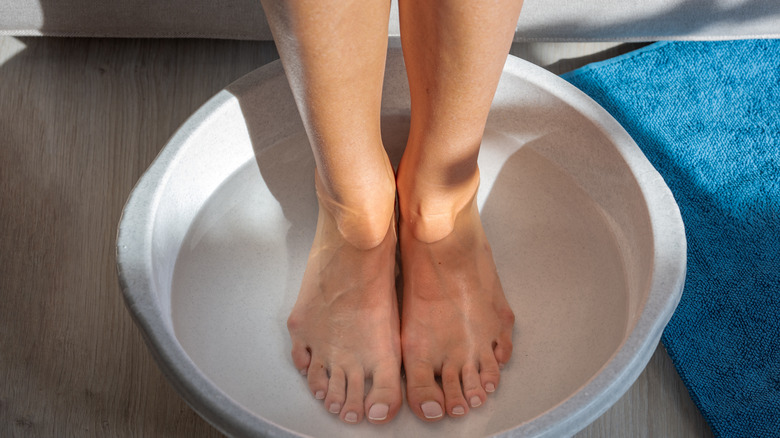Ways To Treat Bunions At Home So You Don't Need Surgery
Bunions are among the most common foot problems among adults. Characterized by a growth that gradually develops on the joint of the side of the big toe, a bunion can be uncomfortable, embarrassing, and painful. This growth forces the toe to curve against the second toe; in severe cases, it can even overlap the second toe, as OrthoInfo explains. Over time, they can get worse and become more painful.
Bunions form due to pressure being placed on the big toe joint, which eventually leads to a misalignment of the bone, ligaments, and tendons. This misalignment eventually causes a mass to form between two bones: the phalanx (bone under the toenail area) and the metatarsal (located directly under the phalanx). WebMD claims this process takes years. The initial growth is small, but it can gradually become more prominent.
Surgery is a popular treatment option for bunions, but it's not the only option, nor is it always necessary. Some doctors wouldn't recommend surgery if the bunion is in the early stages, or if it's not causing severe pain (via GoodRx Health). Plus, the procedure can be expensive. The good news is, there are ways to treat bunions at home or at a doctor's office, without surgery. Although they won't remove the bunions, they can keep them from getting worse or causing discomfort or pain.
Wear the right shoes
Mayo Clinic claims wearing tight-fitting shoes can contribute to bunion progression. It can also cause pain when you walk. On the other hand, wearing shoes that don't fit tightly can provide relief for your bunions and prevent them from becoming larger and more painful. Consider buying shoes in a wide size, if available. Otherwise, make sure they fit well without squeezing your toes or any other part of your feet. If they feel a little too tight, consider going up half a size or choosing a different shoe style.
You should also avoid wearing shoes with high heels since these types of shoes add pressure to bunions. This pressure can have the same negative effect as any other tight-fitting shoes. Does that mean you should completely eliminate all heels from your shoe closet and never wear them again? Not necessarily. Foot & Ankle Clinics P.A. recommends keeping the height at two inches or less and opting for shoes that provide adequate cushioning.
Regardless of what type of shoes you wear, the American Orthopaedic Foot & Ankle Society says you should always make sure there's about half an inch of space between the shoe and the tip of your toes. If you're buying shoes for running, you should go up one-half or whole size to accommodate foot swelling, which occurs naturally with running.
Spend more time barefoot
Wearing wide, comfortable shoes that don't squeeze your feet is a great way to prevent bunion pain when you're out in public, but when you're at home, you have an even better option: skip the shoes entirely and embrace walking on your bare feet. Walking around barefoot can keep bunion discomfort at bay while providing additional benefits.
Being barefoot naturally spreads the toes out as you walk, which strengthens the foot muscles and exercises the foot joints. According to Bunion Bootie, having stronger feet can provide pain relief for bunions. It can also reduce pressure on the toes, which then curbs inflammation.
Walking barefoot on sand provides even more benefits, whether you have bunions or not. Wachtel Family Foot Care claims it can smooth the feet the same way a pumice stone can. Bunions can cause calluses, so if you have them, a nice barefoot walk on the beach can reduce them naturally. It can also help you have better balance.
Get a steroid injection, oral medications, or topical creams
Ankle, Foot & Orthotic Centre lists the four stages/grades of a bunion. The higher the grade, the worse the foot deformity is. Just as with many other conditions, the higher stage usually equates to more pain. When it comes to bunions, this pain can occur throughout the day, even when you're not on your feet.
Inflammation and stiffness at the site of the bunion are also common. This is why doctors sometimes prescribe a cortisone (steroid) injection, as Berkshire Podiatry Center, Ltd explains. If you're not comfortable taking a steroid, or if you just don't like needles, you can take an over-the-counter pain medication for pain relief and inflammation instead. Ibuprofen and aspirin are a couple of options. You can also get prescription medication from your doctor or use a topical pain medication in a cream, gel, or lotion form that penetrates the skin to provide relief.
Maintain a healthy weight
Being overweight means exerting more pressure on your feet when you walk and stand. According to a study published in "Obesity Research & Clinical Practice" that analyzed the correlation between foot pain and obesity in men and women, 25% of the participants who were obese — based on their BMIs — also had bunions (via National Library of Medicine). Obesity can both cause and worsen a bunion, due to its ability to lead to overpronation, which is when the ankles roll inward when you walk.
If you're currently obese or otherwise overweight, losing weight can provide some much-needed relief for your bunions. It's widely known that combining diet and exercise is the best way to lose weight and keep it off. However, if your bunions are preventing you from being on your feet for an extended period of time, there are several exercise options available that don't involve standing. You can try rowing (on water or with an indoor rowing machine), riding a bike (outdoor or stationary), or using an elliptical.
Use custom or over-the-counter orthotics
If your bunions are in the early stages, New Canaan Podiatry claims using custom orthotics (shoe inserts) can help prevent them from progressing. Your doctor can make an imprint of your feet to create orthotics that are made specifically for your bunions. There are also online impression kits that allow you to make impressions of your feet from home, ship them back to the company, and get your customized inserts.
These orthotics can help you balance your weight properly when you walk, improve your balance, and ensure proper foot alignment. Since improper foot alignment contributes to the progression of bunions, the support provided by orthotics can ultimately prevent bunions from getting worse while providing pain relief.
You can also find non-custom insoles for a fraction of the cost on Amazon and other retailers, according to The Strategist. They probably won't be as effective though, since they won't be tailored to the specific shape of your feet and bunions.
Stretch your toes
Stretching can benefit various parts of the body and prevent injury. It can benefit your bunions as well. Bunions are known to cause stiffness in the toes, but doing some simple foot and toe stretches can loosen them up. Capital District Podiatry provides some stretching options. You can pull, curl, and flex the toes. You can also use a resistance band or pick up marbles with your toes.
For the pull stretch, use your fingers to pull your big toe with the bunion on it in the opposite direction of the other toes so that it's aligned in the place that it should be. Hold the toe in this position for about 10 seconds before repeating. For the curl stretch, curl all the toes toward the soles of your feet, hold for a few seconds, and uncurl. Repeat about 10 times. For the flex stretch, lean your toes against the base of a wall while pushing your foot down to the ground. Hold for a few seconds and repeat.
For the resistance band stretch, place a resistance band around the big toe while your feet are in front of you. Use the band to pull your big toe toward you while pulling the toe toward the ground to create resistance. And for the pick-up stretch, take some marbles or any other similar items and place them on the floor. Use your toes to pick them up and move them about a foot away.
Use hot and cold therapy
Cold therapy, also known as cryotherapy, and heat therapy are both used to provide pain relief to various parts of the body. Both can be used to treat bunion pain, but they provide different effects on the body.
Ice as a means of cold therapy is widely known to provide relief for inflammation, so if any part of your feet is swollen, soaking them in cold water can help. Using an ice pack or other frozen items directly on the bunion can also help. According to Healthine, cold therapy reduces inflammation by decreasing blood flow. Heat therapy, on the other hand, does the opposite of cold therapy; it improves blood flow where it's applied, which can be beneficial if you experience cramping or stiffness as a result of your bunions. You can either soak your feet in warm water or use a heating pad to experience these relieving effects.
Bunions can't be removed without surgery, but surgery doesn't have to be the only option to treat them. Heat and cold therapy, in addition to stretching, wearing the right shoes, walking barefoot when you can, taking pain meds, maintaining a healthy weight, and/or wearing orthotics can also help.
